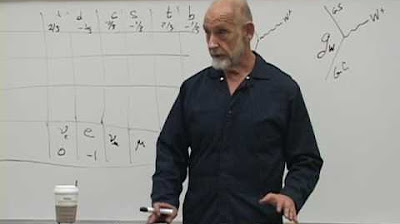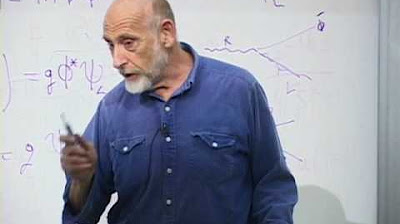The Weak Nuclear Force: Quantum Chameleon
TLDRThis video script delves into the unique properties of the weak nuclear force, contrasting it with the other fundamental forces. It explains how particles decay via the weak force, leading to 'flavor changing'—a phenomenon exclusive to this force, which alters a particle's identity without changing its charge. The script highlights the role of W and Z bosons in this process, with the W boson being responsible for flavor changes. The absence of flavor changing neutral currents (FCNCs) in the Standard Model is also discussed, with their potential observation signaling new physics. The video invites viewers to ponder the mysteries of the weak force and its implications for our understanding of the universe.
Takeaways
- 🔬 The weak nuclear force has unique properties that allow particles to change their identity during decay.
- 🌐 In the Standard Model, there are three quantum forces: the strong nuclear force, the weak nuclear force, and electromagnetism, each mediated by bosons.
- 🤔 The weak force's interaction with particles is characterized by 'flavor changing', which is not observed with other forces.
- 💡 The strong nuclear force is transmitted by gluons, electromagnetism by photons, and the weak force by W and Z bosons.
- ✨ When a particle like a top quark emits a photon, it retains its identity, unlike during weak force interactions.
- 🚫 The weak force's flavor changing is unique to the emission of W bosons, not Z bosons, due to their different properties.
- ⚡ The Z boson's neutral charge prevents it from causing a change in the charge of the emitting particle, unlike the W boson.
- 🔍 Flavor changing neutral currents (FCNCs) are theoretically forbidden in the Standard Model and their observation would indicate new physics.
- 🧠 The discovery of quarks and their properties, such as charm and top quarks, was influenced by the understanding of FCNCs.
- 🎓 The script encourages young minds to explore and solve the mysteries of the weak force's flavor changing properties.
- 🌟 The weak force's ability to change particle identity is a profound aspect of the universe that scientists are still trying to understand.
Q & A
What are the four known fundamental forces in physics?
-The four known fundamental forces in physics are the strong nuclear force, the weak nuclear force, electromagnetism, and gravity.
What is the Standard Model and how does it relate to the forces?
-The Standard Model is a theoretical framework in particle physics that describes three of the four known fundamental forces (excluding gravity) and classifies all known elementary particles. It explains how particles interact through the exchange of force-carrying particles called bosons.
What are bosons and how are they related to the forces?
-Bosons are particles that mediate the fundamental forces. The strong nuclear force is mediated by gluons, the weak nuclear force by W and Z bosons, and electromagnetism by photons.
How does a particle change its identity during a weak force interaction?
-A particle can change its identity, or 'flavor', during a weak force interaction when it emits a W boson. This process is known as 'flavor changing' and is unique to the weak force.
What is the difference between the weak force and other forces in terms of particle decay?
-Unlike the electromagnetic and strong forces, which do not change the identity of the particle involved in the interaction, the weak force can change the particle's identity through a process known as 'flavor changing' when a W boson is emitted.
Why does the emission of a Z boson not change the flavor of a particle?
-The emission of a Z boson does not change the flavor of a particle because the Z boson has zero electrical charge, and thus the emitting particle cannot change its charge, which is a requirement for flavor change.
What are flavor changing neutral currents (FCNC) and why are they forbidden in the Standard Model?
-Flavor changing neutral currents (FCNC) are hypothetical processes where a particle changes its flavor without a change in electric charge. They are forbidden in the Standard Model because quarks come in matched pairs with charges of +2/3 and -1/3, which prevents such flavor changes without a charge change.
Why is the search for flavor changing neutral currents (FCNC) significant?
-The search for FCNCs is significant because their observation would indicate new physics beyond the Standard Model, providing clues to solve existing mysteries and potentially revealing new fundamental forces or particles.
What are virtual particles and how do they relate to energy and momentum conservation?
-Virtual particles are temporary fluctuations that can briefly violate conservation laws like energy and momentum, as allowed by the uncertainty principle. They are invoked to explain phenomena such as the slight mass difference required for a particle to emit a photon, as mentioned in the script.
How does the weak force's flavor changing property affect our understanding of the universe?
-The flavor changing property of the weak force is intriguing and suggests that there may be deeper principles at work in the universe. While the exact implications are still unclear, it is an area of active research that could lead to a better understanding of fundamental physics.
What role do W and Z bosons play in the weak nuclear force?
-W and Z bosons are the carrier particles of the weak nuclear force. While the Z boson does not change the flavor of the particle it interacts with, the W boson is responsible for changing the flavor, leading to processes like beta decay.
Outlines
🔬 Particle Decay via the Weak Force
This paragraph introduces the unique properties of the weak force, one of the four fundamental forces in nature, and its role in particle decay within the framework of the Standard Model. It explains that the weak force is transmitted by W and Z bosons and highlights the phenomenon of 'flavor changing' where the weak force alters the identity or 'flavor' of particles, such as a top quark transforming into a bottom quark upon emitting a W boson. This is contrasted with other forces like electromagnetism and the strong nuclear force, which do not change the identity of the particle involved in the interaction. The paragraph also touches on the conservation of energy and momentum, introducing the concept of 'virtual particles' as an underlying quantum mechanical principle.
🚫 The Mystery of Flavor Changing Neutral Currents (FCNC)
The second paragraph delves into the concept of flavor changing neutral currents (FCNC), a phenomenon where a particle's identity changes without a change in electric charge, which is theoretically possible but has never been observed. The explanation connects this to the discovery of quarks and the underlying theory proposed by Sheldon Glashow, John Iliopoulos, and Luciano Maiani in 1970, which stated that FCNCs are forbidden when quarks are paired with opposite charges. This theory predicted the existence of charm and top quarks before their experimental discovery. The paragraph concludes by emphasizing the ongoing search for FCNCs as a potential indicator of new physics beyond the Standard Model, and it invites the audience to consider the challenge of solving this enduring mystery.
Mindmap
Keywords
💡Weak force
💡Standard Model
💡Bosons
💡Top quark
💡Flavor changing
💡W and Z bosons
💡Charge
💡Flavor changing neutral current (FCNC)
💡Quantum mechanics
💡Virtual particles
Highlights
The weak force has unique properties and interacts with particles of certain spin configurations.
The weak force is responsible for how particles decay, as explained within the Standard Model.
Three forces are understood in the quantum world: strong nuclear force, weak nuclear force, and electromagnetism.
Each force is transmitted by bosons: gluons for strong force, W & Z bosons for weak force, and photons for electromagnetism.
A particle like a top quark does not change its identity when emitting a photon.
Energy and momentum conservation in particle interactions involve virtual particles.
During strong force interaction, a top quark changes color but remains a top quark after emitting a gluon.
Emission of a Z boson by a top quark does not change the particle's identity.
Emission of a W boson by a top quark results in a bottom quark, demonstrating flavor change.
Flavor changing is a phenomenon unique to the weak force.
Quarks and leptons can change their flavor through weak force interactions involving W bosons.
The Z boson's lack of electric charge prevents it from causing flavor change.
Flavor changing neutral currents (FCNC) are not observed in the Standard Model.
The existence of charm and top quarks was theorized before discovery due to the prohibition of FCNCs.
The search for FCNCs is ongoing as they would indicate new discoveries beyond the Standard Model.
The weak nuclear force's flavor changing properties are a profound mystery in our understanding of the universe.
The challenge of understanding the weak force's message to the universe is open to future scientists.
Transcripts
Browse More Related Video

Weak Interaction: The Four Fundamental Forces of Physics #2

How the Higgs Mechanism Give Things Mass

Lecture 6 | New Revolutions in Particle Physics: Standard Model

Dr Harry Cliff - Rare beauty - seeking new physics at the LHCb experiment

Lecture 9 | New Revolutions in Particle Physics: Standard Model

All Fundamental Forces and Particles Explained Simply | Elementary particles
5.0 / 5 (0 votes)
Thanks for rating: